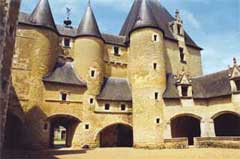Medieval Architecture
Medieval architecture expressed the artistic ideals of a community rather than the genius of the individual architect. The ecclesiastical architecture was predominant. However, the medieval secular architecture was not neglected, and there are many examples of such works which can also be considered representative for the Middle Ages.
Early Medieval Architecture
The earliest forms of Medieval Architecture have two components: the architecture of Rome in the West, and the Eastern or Byzantine one. Sometimes, there is a tendency to make a sharp division between them, and to see “the Early Christian” and the Byzantine works as being completely separate. The early western Christian, also called the Christian-Roman, is regarded as the typical style of the early Christian Church. The Byzantine is considered a very different style, forming a link between classic Roman architecture and the vaulted style of the Romanesque period.

Medieval Architecture: Romanesque
Pisa Cathedral
In reality, early Byzantine is really Christian architecture, its roots go back as far as those of the architecture of Christian Rome, in short the two styles were roughly contemporary and were interacting, being manifestations of the same artistic movement. Byzantine architecture was characterized by continuity, the architects using and developing its typical structural elements for over ten centuries. Another characteristic was the polychromy which remained a distinctive feature of the style throughout its existence, and the sculptured decoration, mainly flat, crisply cut relief, in sharp contrast to the medieval art of the West, which promoted the monumental sculpture, revived from the Carolingian period onwards.
Altough Byzantine style architectural works can be seen from Armenia to France and from Russia to Africa, the centre was always the Empire’s capital city, Constantinople. As a result, no matter which geographical area we are looking at, the new Imperial style kept its main characteristics and general homogeneity.
Romanesque Architecture
Definition of the term Romanesque
Initially, the term defined the Romance languages, and there is a certain similarity between the way these languages appeared and the evolution of architecture. After the break-up of the Roman Empire, new nations arose, based on Latin civilization. They were still differentiated one from another by conditions of race and geography, and many of these nations spoke a language based upon Latin, but different from one nation to another. Thus the Romance languages were based on Rome’s heritage, yet they were national in character.
The architecture evolved in a similar manner. The style based upon Roman as a starting point, but modified by different schools, belonging to different nations, is named Romanesque.
The Dark Ages, starting with the break-up of Roman civilization in the 5th century had their periods of illumination. Manuscripts were written, and buildings erected. Even more, the degree of civilization during the reign of Charlemagne (the Carolingian Renaissance) was brilliant. Was architecture of those times all ‘Romanesque”?
In a very general classification, all western European architecture, except mere Byzantine imitations, roughly from 500 to 1150, can be considered Romanesque. If we were to take a more detailed approach, we can identify the following types of architecture:
- The earlier period can be classified as Carolingian architecture, or Pre-Romanesque. It was the north European style of the Carolingian Renaissance of the late 8th and 9th centuries.- Ottonian architecture, which developed under Emperor Otto the Great (936-975). The style is German and lasted from the mid 10th century until the mid 11th century. The term "Pre-Romanesque" is sometimes applied to architecture in Germany of both Carolingian and Ottonian periods.
- The term Romanesque itself is used for the more restricted period from the late 10th to the 12th century. The Romanesque architecture is ecclesiastical par excellence. Within the larger category of Medieval architecture, the secular is best represented in its Gothic aspects, while the Romanesque period is defined by important churches and monastic buildings.
More on Romanesque Architecture
Gothic Architecture
The name "Gothic," when applied to art, was initially used as a term of opprobrium. Since the Renaissance period, up to the romantic revival of the 19th century, the medieval art was regarded as barbaric. With time, taste changed, and today the beautiful Medieval art is vindicated, as not too many people are paying attention to the origin of the name of “Gothic” anymore. They simply admire the beauty and majesty of the cathedrals and secular buildings.

Medieval Architecture: Gothic
Amiens Cathedral
Gothic architecture originated in Île-de-France, and the style was called "French work." Some writers even asked for the style to be called just “French,” while others suggested to retain the word Gothic, but applied only to the architecture of Île-de-France. According to them, the styles outside France were supposed to be called "pointed architecture." In support of this classification, they argued that fundamentally organic architecture was developed in Île-de-France, and the Gothic styles in other countries were mere imitations, or a superficial application of Gothic details to buildings built mainly in Romanesque style.
However, this is a very extreme point of view. Gothic architecture originated in France, but is not solely French. Using as a main feature the pointed arch, it evolved differently in other countries, resulting in well defined “local” styles. Among them, the amazing Medieval architecture of the unique Italian Gothic, admirably combining the layout of the "basilica" and the Gothic elements.
More on Gothic Architecture

